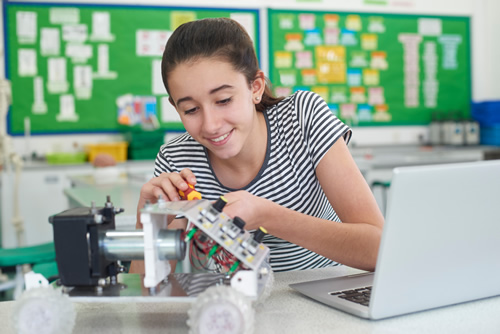Technology is ubiquitous in the lives of today’s students. As technology users, students access technology for entertainment, communication, and learning. Tech literacy, which has become as essential as reading, writing, and arithmetic in preparing students for the future, encourages students to move beyond the role of technology consumers to becoming technology creators.
Encouraging technology creators means engaging students in project-based technology courses that introduce them to coding, design, gaming, and animation. And as students complete projects such as developing an app, creating a 3D video game, or designing a collection, they gain relevant, hands-on experience using industry-standard tools professionals use. Students apply creativity, problem-solving, and critical thinking skills–competencies that are important in preparing students for the future and are applicable to any career, whether it’s in technology or not.
While states are adding computer science as a requirement for high school graduation, fewer than half of K–12 public schools are able to offer technology courses. For Wautoma High School in rural Wautoma, Wisconsin, adding technology courses to the high school offering afforded equity of access to an online solution that would otherwise be prohibitive to a smaller district.
According to Wautoma High School Principal Jennifer Johnson, students who are taking the technology courses are very engaged with their learning and are excited about the different technology skills they are able to pursue.
Finding relevant curriculum and educators with the right skill set can present a challenge. Wautoma selected a suite of technology courses that offered students access to online support from experts to complete their projects and coursework successfully. According to Johnson, it’s extremely important for the school to offer this type of technology. As students go off into the world, Johnson wants her students to be well-versed in the technology requirements of the future, whatever their career choices may be.
As technology continues to drive rapid change, some predict that one-third of the American workforce will have to switch to new occupations by 2030, according to a report published by the McKinsey Global Institute (2017).
For students at Wautoma, adding technology courses made it possible to pursue potential career interests and get a taste for specific industry professions—and industry-standard software and tools—well before college, while collaborating with one another on the progress of their project-based learning opportunities.
Johnson said she believes the courses will also provide a better transition for students from high school to college or professional and technical degrees.
The skills and competencies students need to be successful beyond high school are changing. Students must be prepared to be lifelong learners—to be curious, to problem-solve, to persist, to collaborate and to effectively communicate with others. Engaging in creativity, real-world problem solving, and habits of learning will help them become ongoing learners and prepare them for their future. Today, tech literacy has become a requirement as we prepare for that future.
- 5 ways school districts can create successful community partnerships - November 21, 2024
- Trump picks Linda McMahon to lead, and possibly dismantle, Education Department - November 21, 2024
- 6 ways to create engaging elementary learning spaces - November 20, 2024


